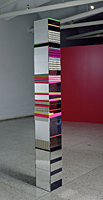Artists, architects and designers have long employed sketches, notes and sculptural maquettes as part of their basic vocabulary. Yet since the early 20th century, as Western art has moved away from straightforward depictions of the natural universe, models and prototypes have evolved from preparatory steps in the creative process to become increasingly autonomous works of art, redefining artistic practice.

Models and Prototypes, which will inaugurate the Mildred Lane Kemper Art Museum’s new “Focus” series Oct. 25 to Dec. 31, investigates the ways in which artists working in a variety of media have expanded use of the model as a new visual force.
Drawn predominantly from the permanent collection, the exhibition is curated by Catharina Manchanda, Ph.D., who joined the Kemper Art Museum last spring, and organized into three distinct yet related sections: Conceptual Models, The Multiple as Model and Structural Models. In all it features 34 works by 22 artists, ranging from modernist pioneers such as Le Corbusier, Marcel Duchamp and Wassily Kandinsky to major contemporary figures such as Daniel Buren, Isa Genzken, Jenny Holzer, Joseph Kosuth and Edward Ruscha.
Conceptual models, which emerged as an outgrowth of abstraction, are typically characterized by the use of ordering systems, often derived from mathematics, language or other visual signs. For example, Alfred Jensen’s Great Mystery I: The Origin of the Chinese Decimal System (1960) is based on the “divine” Lo Shu diagram, while Hannah Weiner’s Signal Flag Poems (1968) draw on the communication system for ships at sea.

The Multiple as Model highlights works by artists who questioned the validity of the original artwork. Examples include Duchamp’s Pocket Chess Set (1944), one of a series of editioned pieces that followed his influential readymade objects; and Joseph Beuys’ Noiseless Blackboard Eraser (1974), an editioned readymade from his famous “Energy Plan for the Western Man” lecture tour.
The final section, Structural Models, hinges on the use and/or deconstruction of architectural or topographic forms, as in Genzken’s Little Crazy Column and Bill II (2001 and 2002), which recall modernist skyscrapers; and Katrin Sigurdardottir’s The Green Grass of Home (1997), which conflates the parks of her native Reykjavik with spaces in San Francisco, Berkeley and New York City. Other examples include Joseph Cornell’s assemblage boxes of the 1940s as well as proposals by Mark Bennett and Claes Oldenburg that bridge real and imagined spaces.
The Focus Series
The “Focus” series explores works from the Kemper Art Museum’s permanent collection within different interpretive frameworks, such as cultural studies, aesthetic theory and intellectual, social and political history. Accompanied by publications with scholarly essays, “Focus” exhibitions — whether dedicated to a particular theme, a single work or an individual artist — highlight seldom-seen pieces while also allowing viewers to reconsider familiar works in new contexts.
Models and Prototypes is one of three inaugural exhibitions — along with an installation of the permanent collection — at Washington University’s new Mildred Lane Kemper Art Museum. A dedication ceremony will begin at 3 p.m. with exhibitions opening from 4:30 to 8 p.m. Wednesday, Oct. 25. All exhibitions are free and open to the public and remain on view through Dec. 31. The Kemper Art Museum is located near the intersection of Skinker and Forsyth boulevards. Hours are 11 a.m. to 6 p.m. Mondays, Wednesdays and Thursdays; 11 a.m. to 8 p.m. Fridays; and 11 a.m. to 6 p.m. Saturdays and Sundays. The museum is closed Tuesdays.
For more information, call (314) 935-4523 or visit kemperartmuseum.wustl.edu.
|
WHO: Mildred Lane Kemper Art Museum WHAT: Exhibition, Models and Prototypes WHEN: Oct. 25 to Dec. 31. Opening 4:30 to 8 p.m. Wednesday, Oct. 25. WHERE: Mildred Lane Kemper Art Museum, Washington University, near the intersection of Forsyth and Skinker boulevards. HOURS: 11 a.m. to 6 p.m. Monday, Wednesday and Thursdays; 11 a.m. to 8 p.m. Fridays; 11 a.m. to 6 p.m. Saturdays and Sundays. Closed Tuesdays. COST: Free and open to the public. INFORMATION: (314) 935-4523 or visit kemperartmuseum.wustl.edu |